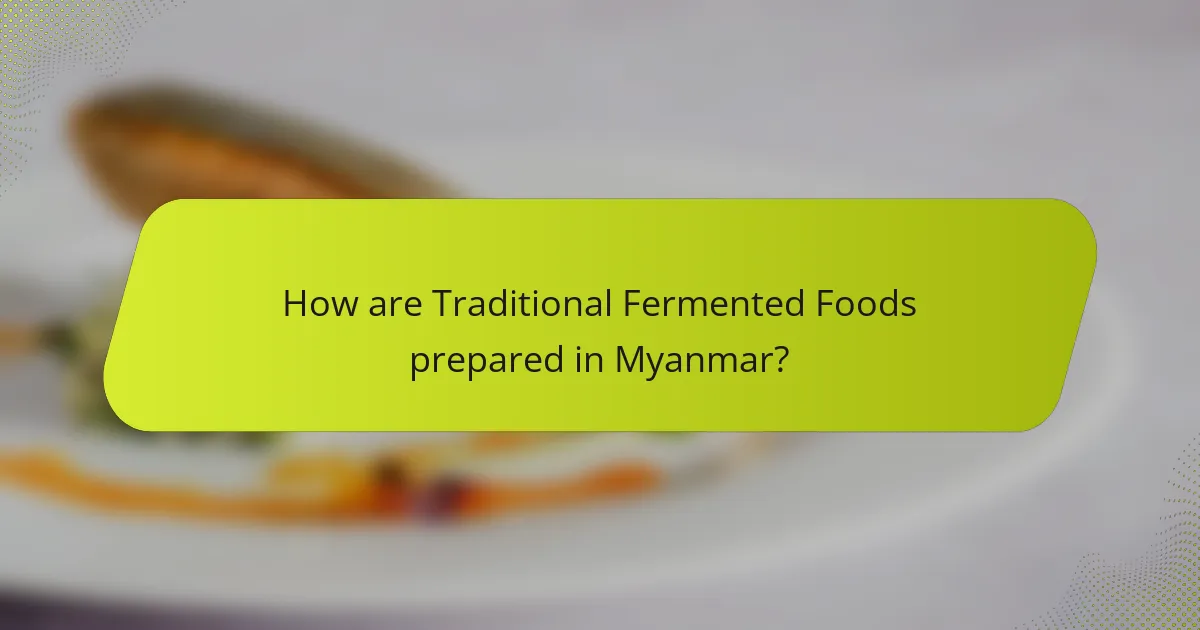Traditional fermented foods in Myanmar, such as ngapi (fermented fish or shrimp paste), pickled vegetables, and fermented rice (htamanè), are essential components of Burmese cuisine and culture. These foods are rich in probiotics, vitamins, and nutrients that enhance digestive health, boost immune function, and support overall well-being. The preparation methods involve natural fermentation processes using ingredients like rice, fish, and vegetables, reflecting Myanmar’s culinary heritage. Traditional fermented foods also play a significant role in cultural practices and community celebrations, fostering a sense of identity among the Burmese people.

What are Traditional Fermented Foods in Myanmar?
Traditional fermented foods in Myanmar include items like ngapi, pickled vegetables, and fermented rice. Ngapi is a fermented fish or shrimp paste, essential in Burmese cuisine. It serves as a condiment and flavor base for many dishes. Pickled vegetables, such as mustard greens and tea leaves, are commonly consumed alongside meals. Fermented rice, known as htamanè, is often used in traditional desserts. These foods are rich in probiotics, contributing to digestive health. They also play a significant role in cultural practices and celebrations in Myanmar.
How are Traditional Fermented Foods defined in Myanmar’s cuisine?
Traditional fermented foods in Myanmar’s cuisine are defined as food products created through the fermentation process using local ingredients. These foods are integral to Myanmar’s culinary heritage and include items such as ngapi (fermented fish paste) and pickled vegetables. Fermentation enhances flavors and preserves food, making it a vital preservation method. The process often involves indigenous techniques passed down through generations. Fermented foods also contribute to the nutritional profile of meals, providing probiotics and enhancing digestion. This practice reflects the cultural significance of food in Myanmar, emphasizing communal preparation and consumption.
What are the key characteristics of these foods?
Traditional fermented foods in Myanmar are characterized by their unique flavors, nutritional benefits, and cultural significance. These foods often undergo a natural fermentation process, which enhances their taste and digestibility. Common examples include fermented soybean products like ‘tofu’ and ‘ngan ye’, which are rich in protein. Fermented vegetables, such as ‘ngapi’ (fermented fish paste), provide essential nutrients and probiotics. The fermentation process also preserves these foods, extending their shelf life. Additionally, traditional methods of preparation are passed down through generations, reflecting the cultural heritage of Myanmar. These foods play a vital role in local diets and culinary practices, showcasing the diversity of flavors in Myanmar’s cuisine.
How do they differ from other fermented foods globally?
Traditional fermented foods in Myanmar differ from other fermented foods globally primarily due to their unique ingredients and preparation methods. Myanmar’s traditional fermentation often utilizes local staples like rice, soybeans, and various vegetables. This results in distinct flavors and textures not commonly found in other cultures.
For instance, fermented soybean products like “tofu” and “ngapi” have specific regional variations. The fermentation process in Myanmar frequently involves natural, spontaneous fermentation rather than controlled methods. This leads to a diverse range of microbial communities, impacting the nutritional profile of the food.
Additionally, Myanmar’s fermentation practices are deeply intertwined with cultural traditions and rituals. Many fermented foods are integral to local diets and are often prepared for specific festivals or ceremonies. This cultural significance sets Myanmar apart from other regions where fermentation may be primarily focused on preservation or commercial production.
Overall, the combination of unique local ingredients, spontaneous fermentation processes, and cultural ties differentiates Myanmar’s traditional fermented foods from those found globally.
What types of Traditional Fermented Foods are prevalent in Myanmar?
Fermented foods in Myanmar include ngapi, a fermented fish paste, and pickled tea leaves known as lahpet. Ngapi is commonly used as a condiment in various dishes. Lahpet is often served as a salad or snack. Other prevalent fermented foods are fermented soybeans called tokyaw and fermented rice known as htamin jin. These foods play a significant role in traditional Myanmar cuisine. They are rich in probiotics and enhance flavor profiles. Fermented foods also contribute to food preservation in Myanmar’s climate.
Which specific foods are commonly fermented in Myanmar?
Commonly fermented foods in Myanmar include pickled tea leaves, known as lahpet. Fermented fish, called ngapi, is also popular. Fermented soybeans, known as tokyaw, are frequently used in dishes. Additionally, rice is often fermented to make traditional alcoholic beverages like htamane. These foods play a significant role in Myanmar’s culinary culture and are integral to various traditional dishes. Lahpet, for example, is often served as a salad or snack. Ngapi is used as a condiment and adds flavor to many meals. Fermented foods in Myanmar contribute to the country’s rich gastronomic heritage.
How are these foods categorized based on their ingredients?
Traditional fermented foods in Myanmar are categorized based on their ingredients into three main groups: plant-based, animal-based, and mixed. Plant-based fermented foods include items like fermented rice, soybeans, and vegetables. Animal-based options primarily consist of fish and dairy products. Mixed categories combine both plant and animal ingredients, such as certain types of fermented sauces. This classification helps in understanding the nutritional profiles and cultural significance of each food type. For instance, fermented rice is a staple in many ethnic cuisines, reflecting local agricultural practices.
What is the historical significance of Traditional Fermented Foods in Myanmar?
Traditional fermented foods in Myanmar hold significant historical importance as they are integral to the country’s culinary heritage. These foods, such as fermented tea leaves and fish sauce, have been consumed for centuries. They reflect the agricultural practices and local biodiversity of Myanmar. Fermentation methods were traditionally used to preserve food and enhance flavors. The process also contributed to food safety and nutrition. Historical records indicate that fermented foods were staples in the diet of various ethnic groups in Myanmar. They are often associated with cultural rituals and community gatherings. The preservation techniques have been passed down through generations, showcasing the rich cultural identity of the nation.
How have these foods evolved over time?
Traditional fermented foods in Myanmar have evolved significantly over time. Initially, these foods were created through natural fermentation processes using local ingredients. Over centuries, cultural exchanges and trade introduced new techniques and flavors. For instance, the fermentation methods have adapted to include various microorganisms, enhancing taste and preservation. Historical records indicate that fermented foods have been integral to Myanmar’s cuisine for centuries, contributing to food security and nutrition. Recent trends show a resurgence in interest due to their health benefits, such as improved gut health. Additionally, modern innovations in production methods have increased accessibility and variety. Thus, traditional fermented foods in Myanmar reflect a blend of historical practices and contemporary influences.
What role do they play in Myanmar’s cultural heritage?
Traditional fermented foods play a significant role in Myanmar’s cultural heritage. They are integral to local diets and daily life. These foods are often prepared using age-old methods passed down through generations. Fermented products like ngapi (fish paste) and pickled tea leaves are staples in Burmese cuisine. They contribute to unique flavors and enhance the nutritional value of meals. Additionally, traditional fermentation practices are linked to community gatherings and celebrations. They reflect local customs and identity, showcasing the agricultural diversity of the region. This culinary tradition fosters social connections among families and communities.

What are the Health Benefits of Traditional Fermented Foods?
Traditional fermented foods offer numerous health benefits. They enhance gut health by providing probiotics, which improve digestion and balance gut microbiota. Research indicates that probiotics can boost immune function and reduce inflammation. Additionally, traditional fermented foods are rich in vitamins, such as B vitamins and vitamin K2, which support overall health. They may also aid in nutrient absorption, making minerals more bioavailable. Studies show that fermented foods can help with lactose digestion in lactose-intolerant individuals. Moreover, they can contribute to mental health by producing neurotransmitters like serotonin during fermentation. Overall, incorporating traditional fermented foods into the diet can lead to better health outcomes.
How do Traditional Fermented Foods contribute to digestive health?
Traditional fermented foods enhance digestive health by promoting beneficial gut bacteria. These foods contain probiotics, which are live microorganisms that support gut flora. The fermentation process increases the bioavailability of nutrients, aiding digestion. Studies show that probiotics can reduce symptoms of irritable bowel syndrome (IBS) and improve overall gut health. Fermented foods also produce enzymes that assist in breaking down food. This can alleviate bloating and discomfort after meals. Additionally, traditional fermented foods are rich in fiber, which supports regular bowel movements. This combination of probiotics, enzymes, and fiber contributes significantly to digestive well-being.
What specific probiotics are found in these foods?
Lactobacillus plantarum and Lactobacillus brevis are specific probiotics found in traditional fermented foods in Myanmar. These probiotics are commonly present in fermented soybean products like ngapi and fermented rice dishes. Lactobacillus plantarum is known for its ability to survive in acidic environments, enhancing gut health. Lactobacillus brevis contributes to the fermentation process and aids in digestion. Studies have shown that these probiotics can improve intestinal microbiota balance. They are also linked to various health benefits, including anti-inflammatory effects.
How do these probiotics affect gut health?
Probiotics positively affect gut health by enhancing the balance of beneficial bacteria. They help prevent the growth of harmful bacteria. Probiotics can improve digestion and nutrient absorption. They also support the immune system by promoting a healthy gut microbiome. Research shows that probiotics can alleviate symptoms of irritable bowel syndrome (IBS). A study published in the Journal of Gastroenterology found that probiotics reduced IBS symptoms in participants. Furthermore, probiotics may help in managing diarrhea, particularly antibiotic-associated diarrhea. Consuming traditional fermented foods rich in probiotics can thus contribute to overall gut health.
What nutritional benefits do these foods provide?
Traditional fermented foods in Myanmar provide various nutritional benefits. They are rich in probiotics, which promote gut health. These foods often contain essential vitamins, such as B vitamins, which support energy metabolism. Fermented foods are also a source of minerals like calcium and magnesium, crucial for bone health. The fermentation process enhances nutrient bioavailability, making it easier for the body to absorb these nutrients. Additionally, they can improve digestion and strengthen the immune system. Studies indicate that regular consumption of fermented foods may reduce the risk of certain diseases, including gastrointestinal disorders.
Which vitamins and minerals are abundant in Traditional Fermented Foods?
Traditional fermented foods are rich in several vitamins and minerals. They commonly contain vitamins such as B vitamins, including B1, B2, B6, and B12. These vitamins play essential roles in energy metabolism and neurological functions. Additionally, traditional fermented foods are abundant in vitamin K2, which is crucial for bone health. Minerals like calcium, magnesium, and potassium are also present in significant amounts. These minerals contribute to various bodily functions, including muscle contraction and nerve transmission. The fermentation process enhances the bioavailability of these nutrients, making them more accessible for absorption.
How do these nutrients support overall health?
Nutrients in traditional fermented foods support overall health by enhancing digestion and boosting immunity. Probiotics present in these foods promote a healthy gut microbiome. A balanced gut microbiome is linked to improved nutrient absorption. Fermented foods are also rich in vitamins and minerals, which are essential for various bodily functions. For instance, vitamin K2 found in fermented soy products supports bone health. Additionally, the fermentation process can increase the bioavailability of nutrients. This means that the body can absorb and utilize them more effectively. Studies show that regular consumption of fermented foods can reduce the risk of chronic diseases. Overall, these nutrients contribute to better health outcomes and enhanced well-being.
Why are Traditional Fermented Foods considered beneficial for immunity?
Traditional fermented foods are considered beneficial for immunity due to their high probiotic content. Probiotics are live microorganisms that provide health benefits when consumed in adequate amounts. They help balance gut microbiota, which plays a crucial role in immune function. A healthy gut microbiome can enhance the body’s ability to fight infections and reduce inflammation.
Research indicates that probiotics can stimulate the production of antibodies and enhance the activity of immune cells. For instance, a study published in the journal “Frontiers in Immunology” highlights that specific strains of probiotics can improve immune responses. Additionally, traditional fermented foods often contain vitamins and minerals that further support immune health.
These foods are rich in nutrients like vitamins B and K, which are essential for maintaining overall health. The fermentation process also increases the bioavailability of these nutrients, making them easier for the body to absorb. Thus, traditional fermented foods contribute significantly to enhancing immunity through their probiotic content and nutrient density.
What is the connection between gut health and immune function?
Gut health significantly influences immune function. The gut hosts a large portion of the body’s immune cells. A balanced gut microbiome helps regulate immune responses. It prevents infections and inflammation. Research shows that gut bacteria produce metabolites that support immune cells. For example, short-chain fatty acids enhance immune system efficiency. Studies indicate that dysbiosis, or imbalance in gut bacteria, can lead to immune disorders. Maintaining gut health through diet can improve overall immunity. This connection underscores the importance of traditional fermented foods in promoting gut health.
How can these foods help in disease prevention?
Traditional fermented foods in Myanmar can help in disease prevention by enhancing gut health and boosting the immune system. These foods contain probiotics, which are beneficial bacteria that improve digestion and nutrient absorption. Improved gut health is linked to a lower risk of gastrointestinal diseases. Additionally, probiotics can help reduce inflammation, a key factor in chronic diseases such as heart disease and diabetes. Research shows that fermented foods can also enhance the body’s natural defenses against infections. A study published in the Journal of Nutrition found that regular consumption of fermented foods is associated with a lower incidence of respiratory infections. Thus, incorporating traditional fermented foods into the diet can significantly contribute to overall health and disease prevention.

How are Traditional Fermented Foods prepared in Myanmar?
Traditional fermented foods in Myanmar are prepared through various methods that involve natural fermentation processes. Common ingredients include rice, fish, and vegetables. The preparation often starts with cooking the main ingredient, such as rice or vegetables. After cooking, the food is allowed to cool to room temperature.
Next, a starter culture or previous batch of fermented food is added to initiate fermentation. This mixture is then placed in a container, often made of clay or bamboo. The container is sealed to maintain humidity and temperature. Fermentation typically lasts from several days to weeks, depending on the type of food and desired flavor.
For example, fermented tea leaves, known as lahpet, are made by steaming and then fermenting the leaves in a controlled environment. This traditional method not only enhances flavor but also preserves the food. The entire process reflects Myanmar’s cultural heritage and culinary practices.
What are the common preparation methods for these foods?
Common preparation methods for traditional fermented foods in Myanmar include steaming, boiling, and soaking. These methods enhance the fermentation process and improve the flavor of the foods. For instance, rice and legumes are often soaked to initiate fermentation. Additionally, some foods undergo a steaming process, which preserves nutrients while allowing fermentation to occur. Fermented fish and vegetables are typically prepared through salting and then left to ferment in jars. The fermentation time varies, ranging from a few days to several weeks, depending on the food type. These methods reflect cultural practices and regional variations in Myanmar’s culinary traditions.
How is the fermentation process initiated?
Fermentation is initiated by introducing microorganisms such as yeast or bacteria to a substrate. This can occur naturally from the environment or through intentional inoculation. The microorganisms then metabolize sugars and other compounds in the substrate. This process typically begins under anaerobic conditions, where oxygen is limited. Temperature and pH levels also influence the initiation. In traditional Myanmar fermented foods, local ingredients often provide the necessary microorganisms. Historical practices show that specific fermentation starters have been used for generations. These methods ensure consistent results and unique flavors in the final product.
What are the typical fermentation times for different foods?
Fermentation times vary significantly across different foods. For vegetables like kimchi, fermentation typically takes 1 to 2 weeks at room temperature. Sauerkraut usually ferments for about 3 to 6 weeks. Miso, a fermented soybean paste, can take anywhere from a few months to several years. Yogurt fermentation generally lasts 4 to 12 hours, depending on the desired thickness and tanginess. Kefir fermentation occurs within 12 to 48 hours. Fermented beverages like kombucha take about 7 to 14 days for optimal flavor. These times can vary based on temperature and specific recipes.
What ingredients are essential in the preparation of Traditional Fermented Foods?
Essential ingredients in the preparation of traditional fermented foods include vegetables, grains, and salt. Common vegetables used are cabbage, radishes, and cucumbers. Grains like rice or millet serve as a base for fermentation. Salt acts as a preservative and aids in the fermentation process.
These ingredients create an environment conducive to the growth of beneficial bacteria. The fermentation process enhances flavors and nutritional value. For example, fermented vegetables are rich in probiotics, which promote gut health. Historical practices in Myanmar highlight the importance of these ingredients in traditional diets.
Which local ingredients are commonly used?
Common local ingredients used in traditional fermented foods in Myanmar include rice, fish, and vegetables. Rice serves as a staple base for many fermented products. Fish is often used in the fermentation process to create sauces and pastes. Vegetables, such as cabbage and radish, are also commonly fermented. These ingredients are integral to the culinary culture of Myanmar. Their use in fermentation enhances flavors and preserves food. Fermented foods contribute to the nutritional value of meals. They are a significant part of the local diet and cultural practices.
How do these ingredients impact the flavor and texture?
The ingredients in traditional fermented foods in Myanmar significantly influence both flavor and texture. Fermentation enhances flavors by producing lactic acid, which adds a tangy taste. Ingredients like rice and legumes contribute to a creamy texture when fermented. The presence of spices and herbs introduces unique flavor profiles, making dishes aromatic and complex. Additionally, the fermentation process can create a bubbly texture due to gas production. This combination of flavors and textures is essential in defining the culinary experience of these foods. Research shows that fermentation can also increase the umami flavor, enriching the overall taste.
What tools and techniques are used in the preparation process?
The tools and techniques used in the preparation process of traditional fermented foods in Myanmar include various utensils and methods. Common tools are clay pots, wooden spatulas, and bamboo containers. Clay pots provide an ideal environment for fermentation due to their porous nature. Wooden spatulas are used for mixing ingredients without introducing contaminants. Bamboo containers are often employed for storage and transport, preserving the food’s quality.
Techniques involve specific steps such as soaking, grinding, and fermenting. Soaking grains or vegetables activates enzymes that aid fermentation. Grinding ingredients enhances texture and flavor, promoting a successful fermentation process. Fermentation itself is a controlled process, requiring specific temperatures and durations to achieve desired flavors and safety.
These tools and techniques are integral to the cultural practices surrounding food preparation in Myanmar. They ensure the quality and safety of fermented foods, which are vital to the local diet and heritage.
What traditional equipment is utilized in Myanmar for fermentation?
Traditional fermentation equipment in Myanmar includes earthenware pots and bamboo baskets. Earthenware pots are commonly used for fermenting various foods, such as pickles and soy sauce. These pots are preferred for their ability to regulate temperature and moisture. Bamboo baskets often serve as containers for steaming and storing fermented products. Both types of equipment have been utilized for generations in Myanmar’s culinary practices. Their use reflects the cultural significance of fermentation in the region. The choice of materials contributes to the unique flavors and textures of traditional fermented foods.
How do modern methods differ from traditional techniques?
Modern methods of preparing fermented foods differ from traditional techniques primarily in their use of technology and controlled environments. Traditional techniques often rely on natural fermentation processes, utilizing ambient temperatures and wild microorganisms. In contrast, modern methods employ precise temperature control and specific starter cultures. This results in more consistent fermentation outcomes and reduced fermentation times. For instance, traditional fermentation can take weeks, while modern techniques can achieve similar results in days. Additionally, modern methods may incorporate industrial equipment, enhancing efficiency and scalability. These advancements allow for greater production volumes and standardized flavors, which are less common in traditional practices.

What is the Cultural Importance of Traditional Fermented Foods in Myanmar?
Traditional fermented foods hold significant cultural importance in Myanmar. They are integral to local cuisine and daily life. Foods like ngapi (fermented fish paste) and pickled vegetables are staples in Myanmar households. These foods are often associated with traditional practices and rituals. Fermentation techniques have been passed down through generations. They contribute to the preservation of food in a tropical climate. Moreover, fermented foods enhance the flavor and nutritional value of meals. They also play a role in community gatherings and celebrations. The consumption of these foods fosters a sense of identity and belonging among the Burmese people.
How do these foods influence social gatherings and celebrations?
Traditional fermented foods in Myanmar play a significant role in social gatherings and celebrations. They serve as a central element in communal meals, fostering a sense of togetherness. Fermented foods, such as ngapi and lahpet, are often shared among family and friends during festivities. Their unique flavors stimulate conversation and create a joyful atmosphere.
These foods also symbolize cultural heritage and identity. In Myanmar, traditional dishes are integral to religious and cultural events. For example, during festivals, specific fermented foods are prepared to honor traditions and ancestors. The preparation and sharing of these foods strengthen community bonds.
Additionally, many fermented foods are associated with health benefits. Their nutritional value encourages people to gather and celebrate wellness. This combination of cultural significance and health aspects enhances the overall experience of social gatherings.
What traditional dishes incorporate fermented foods during festivals?
Traditional dishes that incorporate fermented foods during festivals in Myanmar include fermented tea leaf salad (lahpet), fermented rice cakes (mont let), and pickled vegetables (achar). Lahpet is a popular dish made from fermented tea leaves and is often served during celebrations. Mont let is made from fermented rice and is enjoyed during traditional festivities. Achar consists of various pickled vegetables, which are commonly present at festival meals. These dishes highlight the cultural significance of fermentation in Myanmar’s culinary traditions.
How are these foods shared among families and communities?
Traditional fermented foods in Myanmar are shared among families and communities through communal meals and gatherings. These foods often serve as staples during celebrations and festivals, fostering social bonds. Families prepare large quantities to ensure there is enough for everyone. Sharing food symbolizes hospitality and strengthens relationships within the community. Traditional practices dictate that food is often offered to guests as a sign of respect. Additionally, the preparation of these foods is frequently a communal activity, involving multiple family members. This collective effort enhances the sense of community and cultural identity. Historical customs emphasize the importance of sharing food, which has been passed down through generations.
What role do Traditional Fermented Foods play in Myanmar’s daily life?
Traditional fermented foods are integral to Myanmar’s daily life. They serve as staple components in meals, enhancing flavor and nutrition. Fermented foods like ngapi (fermented fish paste) and pickled vegetables are common in local cuisine. These foods contribute beneficial probiotics, promoting digestive health. They also play a role in cultural practices and rituals. Fermented foods are often shared during festivals and gatherings, symbolizing community and togetherness. The preparation of these foods is often a communal activity, fostering social bonds. Their use reflects Myanmar’s agricultural practices and local resources. Overall, traditional fermented foods are essential for both sustenance and cultural identity in Myanmar.
How are these foods integrated into everyday meals?
Traditional fermented foods in Myanmar are integrated into everyday meals as staple components. These foods, such as fermented soybeans and pickled vegetables, are commonly served with rice. They enhance flavor and provide essential nutrients. Fermented foods are often used in soups and stews, adding depth to the dishes. They are also consumed as side dishes during meals. In Myanmar, these foods are valued for their health benefits, including improved digestion. The integration reflects cultural practices and local culinary traditions. Their presence in daily diets underscores their importance in nutrition and community life.
What significance do they hold in local customs and rituals?
Traditional fermented foods in Myanmar hold significant cultural importance in local customs and rituals. They are often integral to celebrations and ceremonies, symbolizing community and togetherness. For instance, fermented foods like ngapi are commonly used in traditional feasts and religious offerings. These foods are believed to connect individuals with their heritage and ancestors. Additionally, the preparation and sharing of these foods foster social bonds among families and communities. Historical practices indicate that fermented foods have been part of Myanmar’s culinary traditions for centuries, reinforcing their role in cultural identity. The consumption of these foods during festivals reflects their significance in maintaining cultural continuity.
How can one incorporate Traditional Fermented Foods into a modern diet?
Incorporating traditional fermented foods into a modern diet can enhance nutrition and flavor. Start by adding fermented foods like kimchi, sauerkraut, or yogurt to meals. These foods provide probiotics that support gut health. Use them as toppings on salads, sandwiches, or rice dishes. Consider making smoothies with kefir or yogurt for a probiotic boost. Include fermented sauces, such as miso or soy sauce, to flavor dishes. Cooking with these ingredients retains their benefits and introduces unique tastes. Research shows that fermented foods can improve digestion and nutrient absorption. These foods have been part of various cultures for centuries, illustrating their longstanding value in diets.
What are some easy recipes for making these foods at home?
Fermented foods in Myanmar can be made easily at home with simple recipes. One popular dish is fermented tea leaf salad, known as Lahpet. To prepare Lahpet, first, steam tea leaves for 30 minutes. Then, mix the leaves with sesame seeds, peanuts, garlic, and lime juice. This dish is refreshing and nutritious.
Another easy recipe is fermented soybean paste, or Ngapi. To make Ngapi, soak soybeans overnight, then boil them until soft. Mash the beans and mix with salt. Let the mixture ferment for a week in a cool place. This paste adds flavor to various dishes.
A third recipe is fermented bamboo shoots, called Nyaung. Cut bamboo shoots into thin strips and soak them in water for three days. Change the water daily. After soaking, drain and mix with salt and spices. Let them ferment for another week. These bamboo shoots can be used in soups and salads.
These recipes highlight the simplicity and cultural significance of traditional fermented foods in Myanmar.
How can one enjoy the health benefits while respecting traditional practices?
One can enjoy the health benefits of traditional fermented foods in Myanmar by incorporating them into a balanced diet while honoring cultural practices. Consuming foods like ngapi and fermented vegetables provides probiotics and nutrients beneficial for gut health. Engaging with local communities and learning about their preparation methods fosters respect for traditions. Participating in festivals or rituals associated with these foods enhances appreciation and understanding. Supporting local producers ensures that traditional practices are preserved. This approach maintains cultural significance while allowing individuals to reap health benefits.
Traditional fermented foods in Myanmar, such as ngapi, lahpet, and fermented rice, are essential components of the country’s culinary heritage. These foods are defined by their unique preparation methods, which involve natural fermentation processes that enhance flavor and nutritional value. The article explores the health benefits of these foods, including their role in digestive health and immunity, as well as their cultural significance in social gatherings and rituals. Additionally, it discusses the preparation methods, common ingredients, and the historical context of these foods, emphasizing their importance in daily life and community identity in Myanmar.
